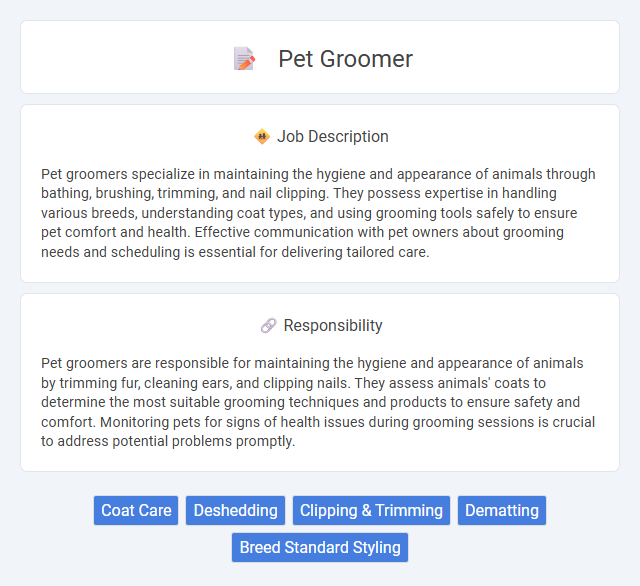
Pet groomers specialize in maintaining the hygiene and appearance of animals through bathing, brushing, trimming, and nail clipping. They possess expertise in handling various breeds, understanding coat types, and using grooming tools safely to ensure pet comfort and health. Effective communication with pet owners about grooming needs and scheduling is essential for delivering tailored care.
Individuals with a strong sense of patience and a genuine love for animals are likely to thrive in a pet groomer job, as the role often involves handling pets that may be anxious or uncooperative. Those who can tolerate occasional physical challenges, such as bending or standing for extended periods, and possess good hand-eye coordination might find this career rewarding. People prone to allergies or discomfort around animals could face difficulties, making the suitability for the job somewhat dependent on personal health and temperament.
Qualification
A pet groomer must have a strong understanding of animal behavior and grooming techniques to ensure the safety and comfort of pets during the grooming process. Professional qualifications often include certification from recognized institutions such as the National Dog Groomers Association of America (NDGAA) or the International Professional Groomers, Inc. (IPG), along with hands-on experience in handling various breeds and grooming tools. Essential skills include attention to detail, knowledge of different coat types, and the ability to identify signs of health issues in pets.
Responsibility
Pet groomers are responsible for maintaining the hygiene and appearance of animals by trimming fur, cleaning ears, and clipping nails. They assess animals' coats to determine the most suitable grooming techniques and products to ensure safety and comfort. Monitoring pets for signs of health issues during grooming sessions is crucial to address potential problems promptly.
Benefit
Pet groomers likely enjoy benefits such as flexible working hours and the opportunity to build bonds with animals, which can enhance job satisfaction. There is a probable advantage in gaining hands-on experience with various breeds, contributing to professional growth. Access to pet care knowledge and the potential for tips might further improve their overall compensation.
Challenge
The pet groomer job likely involves managing a variety of challenges such as handling nervous or aggressive animals, which requires patience and keen observation to ensure safety. It probably demands proficiency in using grooming tools and techniques tailored to different breeds, making continuous learning essential. Stress levels might fluctuate depending on workload, emphasizing the need for resilience and effective time management.
Career Advancement
Pet groomers can advance their careers by gaining certifications from organizations like the National Groomers Association or completing specialized training in breed-specific grooming techniques. Experienced groomers often move into supervisory roles, open their own grooming salons, or become educators and trainers within the pet care industry. Continuous skill development in animal handling and advanced grooming styles enhances opportunities for higher earnings and professional recognition.
Key Terms
Coat Care
Pet groomers specialize in coat care by expertly cleaning, trimming, and conditioning animal fur to maintain health and appearance. Utilizing specialized tools and products, they remove mats, tangles, and dirt while promoting a shiny, healthy coat. Regular grooming reduces skin issues and supports overall pet hygiene and comfort.
Deshedding
Pet groomers specializing in deshedding use professional tools like undercoat rakes and shedding blades to remove loose fur and reduce shedding in pets. Mastery of breed-specific coat types and knowledge of seasonal shedding patterns enhance effectiveness in maintaining pet hygiene and minimizing allergens. Proper deshedding techniques contribute to healthier skin, improved coat condition, and a cleaner home environment for pet owners.
Clipping & Trimming
Pet groomers specializing in clipping and trimming use precise techniques to maintain the health and appearance of various breeds, ensuring fur length is appropriate for comfort and hygiene. Mastery of electric clippers and scissors allows groomers to safely remove mats and tangles, prevent skin irritation, and highlight breed-specific coat styles. Effective clipping and trimming contribute to reducing shedding and controlling odors, enhancing both pet welfare and owner satisfaction.
Dematting
Dematting is a crucial skill for pet groomers, involving the careful removal of tangled fur mats to ensure the pet's comfort and skin health. Effective dematting techniques reduce the risk of skin irritation and infections, enhancing the overall grooming experience for dogs and cats. Mastery in using specialized tools like dematting combs and scissors is essential for safely detangling stubborn mats without causing stress or injury to the animal.
Breed Standard Styling
Pet groomers specializing in breed standard styling ensure that each dog's coat, trim, and overall appearance strictly adhere to the established breed guidelines set by kennel clubs. Expertise in breed-specific grooming techniques, such as the precise scissoring of a Poodle's coat or the hand-stripping required for a Wire Fox Terrier, is essential for maintaining breed integrity. Mastery of these standards not only enhances the pet's aesthetics but also supports show readiness and breed recognition.
 kuljobs.com
kuljobs.com